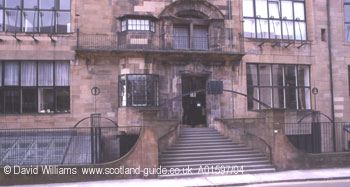The dawn of the twentieth century heralded a new era in Britain. The country`s great political, military and economic strength was being challenged by many other countries and the First World War marked a sea change in Glasgow`s fortunes. The major manufacturing and commercial companies were far less self confident during this period and the important buildings of the time had less of the `over the top` flamboyance of previous decades.
The most significant building of the turn of the century was Charles Rennie Mackintosh`s Glasgow School of Art (see picture); the first phase was erected in 1897-9, towards the close of the Victorian period, and the second phase followed in 1907-9. Some traditional elements of Scottish design were used in the building but, overall, the design was quite startlingly `modern`, with the functional shape of the building being far more important than any ornamentation. The nature of the building is even more astonishing when it is compared with other buildings of the same era, such as the Argyll Chambers (1902-4) in Buchanan Street and the third phase of the Central Thread Agency (1901) in Bothwell Street.
This article is based on the guidebook "The Glasgow Guide".
